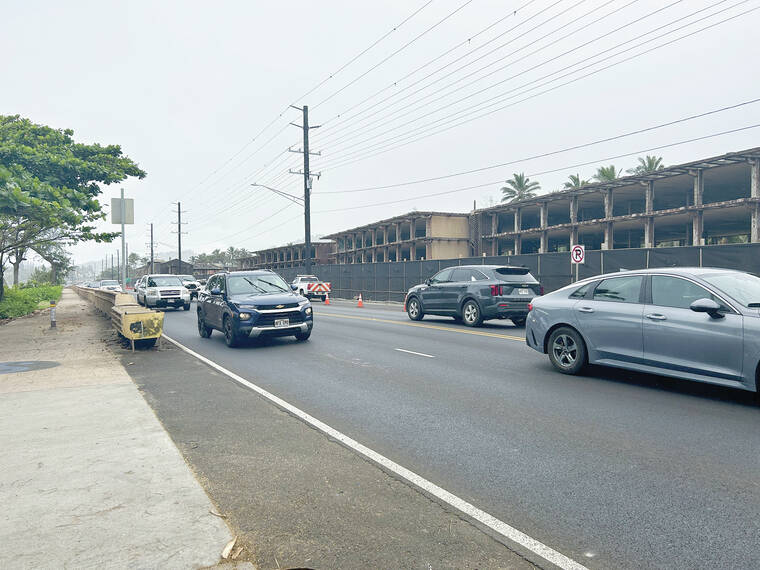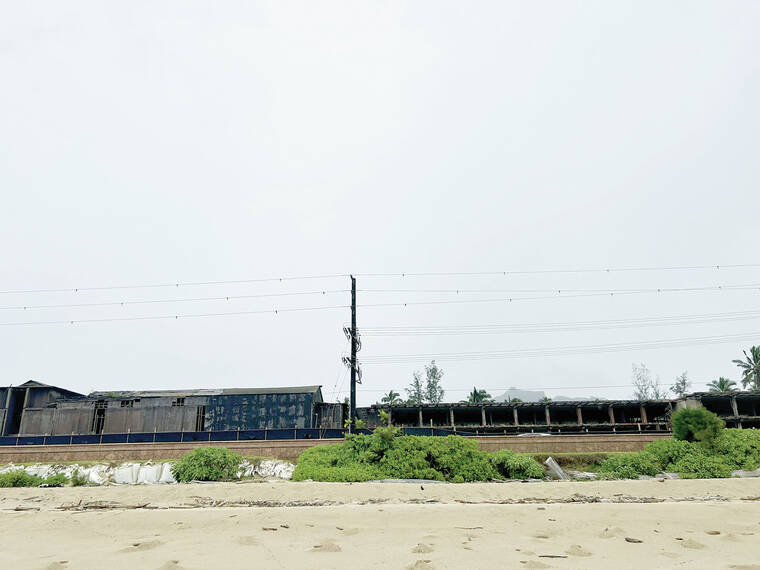LIHU‘E — After a full day of discussion on plans for Coco Palms Resort, the Kaua‘i County Council ultimately decided to defer its resolution asking the Board of Land and Natural Resources to prioritize the property for public use.
Despite public outcry against the resort’s redevelopment and most recently, an alleged land use violation notice from the Department of Land and Natural Resources (DLNR), representatives for the site’s most recent developers, the Utah-based real-estate investment company Reef Capital Partners, also known as RP21 Coco Palms LLC, have repeatedly stated they would continue with plans to rebuild the once iconic resort over a three-year period.
But those plans seemed to come to a halt in a briefing on Wednesday, when the county council discussed the possibility of purchasing the property outright or through eminent domain — a process that would allow the government to take control of the site without the owner’s consent. Mauna Kea Trask, the attorney for RP21 Coco Palms LLC, said eminent domain wasn’t necessary, as his client was willing to sell the land for $22 million.
That possibility was raised during hours of discussion between the county council, several public testifiers against the resort’s development, DLNR Chair Dawn Chang and Trask.
Several hours into the meeting, the Kaua‘i County Council considered a resolution to “provide a council position” to the DLNR, asking the department to consider public use for the property. Resolution No. 2023-44, introduced by council members Felicia Cowden and KipuKai Kuali‘i, was scheduled ahead of an upcoming Board of Land and Natural Resources meeting on May 26, which has RP21 Coco Palms LLC’s revocable land permits on the agenda.
The resolution makes multiple statements detailing how Wailua, where Coco Palms is located, is “one of the most sacred places in the Hawaiian archipelago.” The document notes the rich history of the area, including its time as a royal residence, longstanding coconut groves, and its later destruction by Hurricane Iniki in 1992.
The resolution also points out that the area is subject to heavy traffic congestion, flooding, and the presence of endemic endangered waterbirds, and asks the state to reconsider the revocable permits for three state-owned parcels of land on the site.
But during the meeting on the resolution Wednesday evening, both Trask and testifiers against the resort’s development voiced complaints.
“I’m a fourth-generation Native Hawaiian attorney,” said Trask, who was just recently retained to represent RP21 Coco Palms. “You know, I get a lot of heat for defending developers now, but I defend criminals. I defend the County of Kaua‘i. I’ve defended a lot of people. I’ve prosecuted people. I always try to get it right. And this county should strive to get things right.”
Trask stated the resolution had several “disconcerting” errors, including misspellings of the Hawaiian names of Wailua, an incorrect parcel number, and multiple historically inaccurate statements.
Trask later asked the county council to defer the resolution to give his client time to respond.
“You gotta hear both sides,” he said. “Everything so far that you’ve heard about my client, and what has happened on that site is one side. We have not responded yet. We have said nothing. It is disconcerting to hear everyone takes that as truth.”
Even though documents provided by the Kaua‘i County Council show that at least 20 people submitted written testimony in support of the resolution, multiple people spoke against the resolution during the meeting.
“Regarding the resolution, I ask that you blow the resolution up. There’s a lot of inaccuracies in here besides just a misspelling of the name,” said Sherri Cummings of Kaua‘i.
Cummings said inaccuracies included the location of sacred sites, and incorrect dates surrounding when Wailua and Waimea served as alternate royal residences.
Noa Kanealiiioponoi Mau-Espirito, also of Kaua‘i, testified similarly.
“I just feel like it has to be put together better,” he said. “It’s just a little bit sloppy.”
Testifier Kamealoha Hanohano Pa-Smith also didn’t support the resolution, saying it lacked specificity.
“If the idea is to support the stopping of the hotel … I think that’s what the resolution should say,” he said.
The current resolution doesn’t directly state the hotel should not be built or how the land should otherwise be used. Instead, it is broader, stating “that the Council urges the Board of Land and Natural Resources to act within its power to prioritize public access, uses, and purposes when considering requests for leases, licenses, permits, or other agreements relating to the above-referenced or other relevant parcels in the sacred Wailua area.”
Hanohano Pa-Smith also stated the resolution was written from a Western perspective and was lacking a native worldview.
“What I found concerning is that perspective. It didn’t have that Hawaiian perspective in there,” he said.
Cowden said she moved quickly to draft the resolution because the council wanted to provide a perspective ahead of the upcoming BLNR meeting.
“This isn’t just like it’s my work,” said Cowden, noting she had consulted experts, including Kalani Flores, a Hawaiian Studies professor, and the Kauai Community College History Department.
“There was actually a serious attempt to try and get things right,” she said.
The majority of council members voted to pass recommended amendments to the resolution Wednesday night, deciding to remove a line regarding sacred stones and petroglyphs, as well as other historical information about the region that testifiers and Trask had called inaccurate.
But all council members, with the exception of Kuali‘i, voted to defer the resolution until the next council meeting on May 31.
“I can’t support this tonight,” said Council Chair Mel Rapozo. “My recommendation would be to put this off to the side so the authors can go do their due diligence, confirm, validate whatever, and then we’ll have the discussion again.”
•••
Emma Grunwald, reporter, can be reached 808-652-0638 or egrunwald@thegardenisland.com.




And once again specifics as to money is mostly absent from any discussion. $22 Million to buy it but how much to rehab it ? How much to maintain it ? And how much tax revenue is lost both in the form property taxes and TAT ?
If this land is really so sacred then why did the Council wait 30 years for this proposal ? And why did locals dump 100 old rusty cars in it ? Is this really about preserving the land ? Or is it about one neighborhood community trying to get their way at the expense of all the island’s taxpayers ?